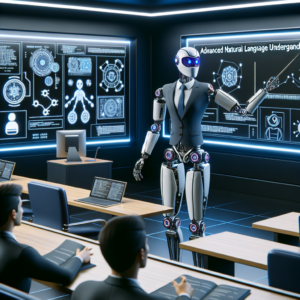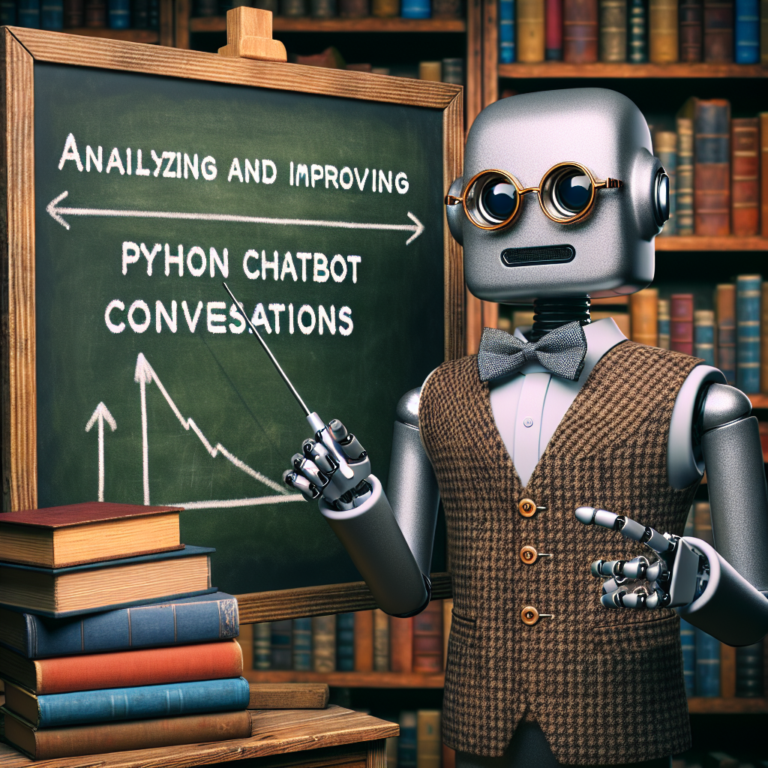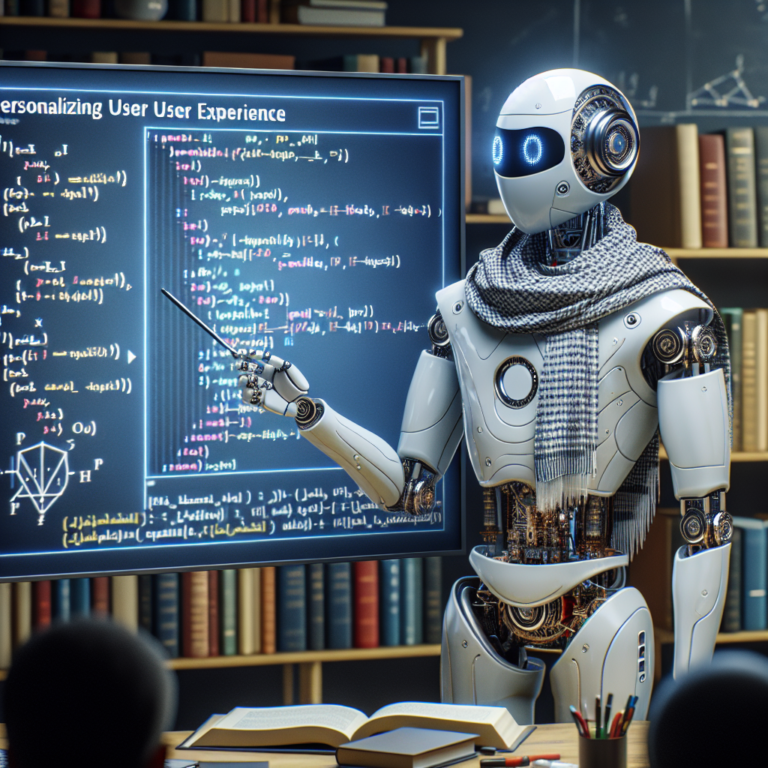1. Exploring the Basics of Advanced NLU in Python Chatbots
Understanding the fundamentals of advanced NLU (Natural Language Understanding) is crucial for enhancing the capabilities of Python chatbots. This section delves into the core concepts that form the foundation of sophisticated chatbot interactions.
Advanced NLU goes beyond basic keyword recognition, enabling chatbots to interpret and respond to user inputs more effectively. By leveraging deep learning techniques, these systems can understand the nuances of human language, such as context, tone, and intent. This capability is vital for creating more human-like and engaging interactions in Python chatbots.
Key components of advanced NLU include:
- Semantic Analysis: This process helps the chatbot grasp the meaning behind words in different contexts, improving its ability to respond appropriately.
- Intent Recognition: Advanced NLU systems can accurately determine the user’s intent, even from complex or ambiguous queries.
- Context Handling: By maintaining the context of a conversation, Python chatbots can provide responses that are coherent and contextually relevant over multiple interactions.
Implementing these advanced NLU features requires a combination of deep learning for chatbots and robust natural language processing libraries. Together, these technologies empower Python chatbots to understand and process human language in a way that is both dynamic and insightful.
By mastering these foundational elements, developers can significantly enhance the conversational abilities of their Python chatbots, making them more intuitive and user-friendly.
2. Key Technologies Powering Advanced NLU
The advancement of advanced NLU in Python chatbots is driven by several key technologies. These technologies enable chatbots to process and understand complex human language, making interactions more natural and intuitive.
At the core of these technologies are deep learning models, which are essential for parsing and making sense of large datasets of human language. These models, such as recurrent neural networks (RNNs) and transformers, are adept at understanding context and semantics, crucial for effective communication.
Another cornerstone technology is natural language processing (NLP) libraries. Libraries like NLTK, spaCy, and TensorFlow provide tools that facilitate the implementation of NLU features. They offer functions for tokenization, part-of-speech tagging, and entity recognition, which are foundational for any NLU system.
Together, these technologies form a robust framework that supports the sophisticated capabilities of advanced NLU in Python chatbots. By integrating these technologies, developers can enhance the chatbot’s ability to understand and interact in a way that feels more human-like.
Here is a simple example of using the spaCy library to implement entity recognition, a common NLU feature:
import spacy
# Load the English NLP model
nlp = spacy.load('en_core_web_sm')
# Sample text
text = "Apple is looking at buying U.K. startup for $1 billion"
# Process the text
doc = nlp(text)
# Extract entities
for entity in doc.ents:
print(entity.text, entity.label_)
This code snippet demonstrates how spaCy can be used to identify and label entities like companies, locations, and monetary values in text, which is vital for understanding user queries in chatbots.
By leveraging these advanced technologies, developers can significantly improve the performance and capabilities of their Python chatbots, making them more effective and engaging for users.
2.1. Deep Learning Models
Deep learning models are at the heart of advanced NLU for Python chatbots. These models enable chatbots to process and understand language in a way that mimics human cognition, crucial for sophisticated interactions.
Among the most effective models are Recurrent Neural Networks (RNNs) and Transformers. RNNs are adept at handling sequences, making them ideal for tasks where context from previous inputs needs to be considered. Transformers, on the other hand, have revolutionized NLU with their ability to process words in parallel and handle long-range dependencies, significantly improving efficiency and accuracy in language understanding tasks.
Here’s a brief overview of how these models contribute to NLU:
- RNNs: They excel in tasks that require memory of previous inputs, such as maintaining conversation context.
- Transformers: Known for their self-attention mechanism, they analyze the entire text input at once, which helps in understanding the relevance of each word in relation to others.
Implementing these models in Python can be facilitated by libraries such as TensorFlow and PyTorch, which provide pre-built modules and functions that simplify the development of complex NLU systems. Here is a simple example using TensorFlow to create a basic RNN model:
import tensorflow as tf from tensorflow.keras.layers import SimpleRNN, Embedding, Dense from tensorflow.keras.models import Sequential # Define the model model = Sequential() model.add(Embedding(input_dim=10000, output_dim=32)) model.add(SimpleRNN(64)) model.add(Dense(1, activation='sigmoid')) # Compile the model model.compile(optimizer='adam', loss='binary_crossentropy', metrics=['accuracy'])
This code snippet sets up a basic RNN with TensorFlow, suitable for binary classification tasks in NLU. By integrating such models, developers can enhance the Python chatbots to not only understand but also predict user intent more accurately, paving the way for more dynamic and responsive chatbot applications.
2.2. Natural Language Processing Libraries
The effectiveness of advanced NLU in Python chatbots heavily relies on the robustness of natural language processing (NLP) libraries. These libraries provide the essential tools needed for deep linguistic data analysis and processing.
Popular NLP libraries such as NLTK, spaCy, and TensorFlow are instrumental in developing advanced NLU capabilities. Each library offers unique features:
- NLTK (Natural Language Toolkit): Great for beginners and education, providing easy-to-use interfaces and a wide range of linguistic resources.
- spaCy: Known for its speed and efficiency, spaCy is suitable for industrial-strength NLP tasks and is highly scalable.
- TensorFlow: While primarily a deep learning framework, it includes support for NLP tasks through its flexible and comprehensive ecosystem.
These libraries facilitate various NLU tasks such as tokenization, syntactic parsing, and entity recognition, which are crucial for understanding and processing user inputs. Here is an example of how to use NLTK for tokenization:
import nltk from nltk.tokenize import word_tokenize # Sample text text = "Hello, how can I help you today?" # Tokenize the text tokens = word_tokenize(text) print(tokens)
This code snippet demonstrates the basic use of NLTK for breaking down a sentence into tokens, a fundamental step in text processing for NLU. By leveraging these libraries, developers can build more sophisticated and responsive Python chatbots that better understand and interact with users.
Integrating these NLP libraries into your chatbot’s architecture not only enhances its linguistic capabilities but also its ability to engage users in a more meaningful and context-aware manner.
3. Implementing Advanced NLU Features in Python Chatbots
Implementing advanced NLU features in Python chatbots significantly enhances their ability to understand and interact with users on a deeper level. This section explores practical steps to integrate these features into your chatbot projects.
Firstly, contextual understanding and intent recognition are crucial. These features allow chatbots to not only comprehend the literal meaning of words but also the context and intent behind user queries. This is achieved through sophisticated machine learning algorithms and extensive training data.
For example, to implement intent recognition, you might use a model trained on user interaction data that categorizes input into intents like ‘booking’, ‘inquiries’, or ‘complaints’. Here’s a simple Python code snippet using TensorFlow to illustrate this:
import tensorflow as tf from tensorflow.keras.models import Sequential from tensorflow.keras.layers import Dense, LSTM, Embedding # Model configuration model = Sequential() model.add(Embedding(input_dim=1000, output_dim=64)) model.add(LSTM(128)) model.add(Dense(10, activation='softmax')) # Assuming 10 possible intents # Compile the model model.compile(optimizer='adam', loss='categorical_crossentropy', metrics=['accuracy']) # Example usage # This model would be trained on labeled data representing different user intents
Additionally, handling complex queries involves parsing and responding to multi-turn conversations where the user might reference previous statements or change the topic abruptly. Techniques such as maintaining a session-based context or using memory networks can be employed to manage these interactions effectively.
By integrating these advanced NLU features, your Python chatbots can achieve a more natural and intuitive user experience, making them more effective in handling real-world tasks and interactions.
Overall, the successful implementation of these features requires a combination of robust NLP tools, careful model training, and ongoing testing and refinement to ensure the chatbot performs well across a variety of conversational scenarios.
3.1. Contextual Understanding and Intent Recognition
Enhancing Python chatbots with advanced NLU capabilities involves significant improvements in contextual understanding and intent recognition. These features are pivotal for chatbots to interact in a more human-like manner.
Contextual understanding allows chatbots to maintain a coherent conversation flow by remembering past interactions. This ability ensures that responses are not only relevant but also personalized, based on the ongoing dialogue. For instance, if a user asks follow-up questions, the chatbot can refer back to the initial topic without needing repeated information.
Intent recognition is another critical aspect, enabling chatbots to decipher the purpose behind a user’s message. Advanced techniques in deep learning for chatbots help in accurately predicting user intent, even when the queries are complex or ambiguously phrased.
Here’s a brief example of how you might implement intent recognition using Python:
from sklearn.feature_extraction.text import TfidfVectorizer from sklearn.svm import SVC # Sample data training_texts = ["Book a flight", "Schedule a meeting", "Play music"] training_labels = ["travel", "calendar", "entertainment"] # Vectorize text vectorizer = TfidfVectorizer() training_vectors = vectorizer.fit_transform(training_texts) # Train a classifier classifier = SVC(kernel='linear') classifier.fit(training_vectors, training_labels) # Predict intent test_text = vectorizer.transform(["I need to fly to New York"]) predicted_label = classifier.predict(test_text) print(predicted_label)
This Python code snippet demonstrates using a Support Vector Machine (SVM) to classify user intents based on their queries. By training the model with labeled examples, the chatbot can learn to recognize various intents, enhancing its interaction quality.
By mastering these technologies, developers can significantly boost the conversational abilities of their Python chatbots, making them more intuitive and responsive to user needs.
3.2. Handling Complex Queries
Handling complex queries effectively is a cornerstone for advanced NLU in Python chatbots. This capability allows chatbots to manage intricate user interactions that require understanding context over multiple exchanges.
To achieve this, developers must integrate sophisticated algorithms that can track conversation threads and adjust responses based on the evolving context. This involves techniques like maintaining a dialogue state or employing memory networks that remember past interactions within a session.
Here are key strategies for handling complex queries:
- Dialogue Management: Utilizing frameworks that manage the flow of conversation, ensuring that the chatbot can handle interruptions, corrections, and context switches effectively.
- Memory Networks: Implementing networks that use previous interactions to inform current responses, crucial for tasks such as booking systems or technical support.
For example, here’s a basic implementation of a dialogue state tracker in Python:
class DialogueStateTracker:
def __init__(self):
self.states = []
def update_state(self, message):
# Process the message and update the state
self.states.append(message)
def get_current_state(self):
return self.states[-1] if self.states else None
# Example usage
tracker = DialogueStateTracker()
tracker.update_state("Hello, I need help with my account.")
print(tracker.get_current_state())
This code snippet illustrates how a simple state tracker can be used to maintain the context of a conversation, enabling the chatbot to provide more relevant and accurate responses based on the user’s ongoing needs.
By mastering these techniques, your Python chatbots can handle complex queries more effectively, leading to a smoother and more intuitive user experience.
4. Case Studies: Successful Advanced NLU Python Chatbots
Exploring real-world applications of advanced NLU in Python chatbots provides valuable insights into their practical effectiveness and the innovative strategies behind their success.
One notable example is a customer service chatbot developed for a major online retailer. This chatbot utilizes deep learning algorithms to understand customer inquiries and provide accurate, context-aware responses. The system is trained on a vast dataset of customer interaction logs, enabling it to handle a wide range of queries from order tracking to product recommendations.
Another successful case involves a healthcare provider’s chatbot designed to assist patients with appointment scheduling and medical inquiries. By integrating advanced NLU capabilities, the chatbot can interpret complex patient inputs, such as symptoms or treatment questions, and guide them appropriately, significantly reducing the workload on human staff.
Key achievements from these case studies include:
- Enhanced Customer Interaction: Chatbots equipped with advanced NLU can engage in more meaningful and human-like conversations, improving user satisfaction.
- Operational Efficiency: Automating routine inquiries allows organizations to allocate human resources to more complex tasks, enhancing overall efficiency.
- Scalability: Advanced NLU enables chatbots to scale their interaction capabilities without compromising the quality of service as user demand increases.
These examples demonstrate the transformative impact of advanced NLU in Python chatbots, showcasing their ability to not only understand but also anticipate user needs, making interactions more intuitive and effective.
By studying these case studies, developers can gain insights into successful strategies and common challenges, aiding them in designing more sophisticated chatbot systems that leverage the full potential of advanced NLU.
5. Best Practices for Optimizing NLU in Python Chatbots
To enhance the effectiveness of advanced NLU in Python chatbots, it is crucial to adhere to several best practices. These guidelines ensure that your chatbot not only understands the user’s intent but also responds in a contextually appropriate manner.
Continuous Training and Model Updates: Regularly update the NLU model with new data and user interactions. This continuous learning process helps the chatbot to adapt to new phrases, slang, and evolving language use.
Utilize High-Quality Datasets: The accuracy of an NLU system heavily relies on the quality of the training data. Ensure that the datasets are diverse, representative, and free of biases to train the chatbot effectively.
Implement Multi-Turn Context Management: Advanced NLU should handle conversations that span multiple turns. Maintaining context over a series of interactions helps the chatbot understand the flow of the conversation, making its responses more relevant and accurate.
Testing and Validation: Rigorously test the chatbot across various scenarios to ensure it understands a wide range of inputs. Validation should include stress testing with ambiguous or complex queries to evaluate the robustness of the NLU capabilities.
Integration of Feedback Mechanisms: Allow users to provide feedback on the chatbot’s performance. This feedback can be instrumental in refining the NLU processes and enhancing user satisfaction.
By following these best practices, developers can significantly improve the performance of their Python chatbots, making them more intuitive and effective at handling real-world interactions. These strategies not only optimize the chatbot’s understanding capabilities but also enhance the overall user experience.



